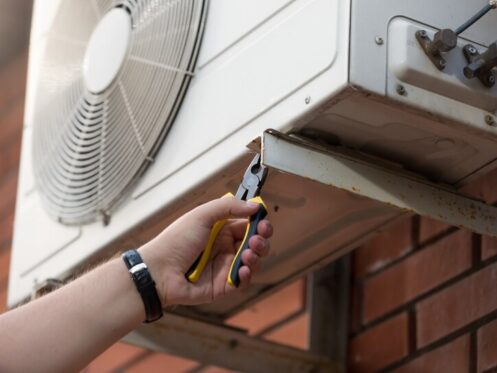When your air conditioner stops cooling the way it should, especially during the summer heat in Lancaster, the issue might not always be what you expect. Many homeowners focus on the mechanical components but often forget about something much smaller, yet just as important: the condensate drain line. This line helps remove the moisture your AC system pulls from the air. When the drain line clogs, that moisture has nowhere to go, which can create bigger problems in your home.
Ignoring a clogged condensate drain line can lead to leaks, water damage, and even the potential for mold. It can also interfere with how well your AC runs, forcing it to work harder and potentially shortening its lifespan. By dealing with this issue early, you can avoid these problems and keep your system functioning efficiently all summer long.
Identifying Symptoms Of A Clogged Condensate Drain Line
The first step to fixing any problem is seeing the signs early. A clogged condensate drain line often shows clear warning signs around your unit or inside your home. Knowing what to watch for can help stop further damage and unnecessary hassle.
Here are some of the most common symptoms that your AC condensate drain line might be clogged:
– Water pooling around the indoor unit
– Musty or damp smells near the vents or unit
– AC shutting off before reaching the set temperature
– A full or frequently triggering drain pan sensor
– Damp spots on walls or ceilings around the AC system
These symptoms are more than just an inconvenience. If a clog goes untreated, it can lead to excess moisture building up inside or around your system. That kind of constant damp environment often leads to mildew or mold, which can affect air quality over time. In more serious cases, water may leak through floors or ceilings, damaging drywall and personal belongings.
For example, one homeowner in Lancaster noticed a persistent damp smell in their hallway. After checking the indoor unit, they found overflow from a clogged drain line had been slowly soaking the carpet near the wall without making noise or leaving obvious signs. Catching the issue earlier would have saved them from replacing the pad and flooring entirely.
Main Causes Of AC Condensate Drain Line Clogs
Understanding why the drain line clogs in the first place gives you a better chance at preventing it. The AC system pulls humidity from the air, and that moisture drains away through a line into either your plumbing or an exterior discharge point. Over time, the line can become blocked by a few common culprits.
1. Dust and dirt buildup: Airborne particles make their way into the system and mix with the condensate water. This mix can create sludge that sticks to the walls of the drain line.
2. Mold and algae: Since the line is dark and damp, it becomes a perfect place for mold or algae to grow, especially if water stays in the line for long periods.
3. Debris from construction or remodeling: If any work has been done near your AC unit, drywall dust or small particles may find their way into the system.
4. Pipe alignment problems: A poorly pitched or slightly compressed drain line slows water flow and encourages buildup and clogging.
5. Neglected maintenance: Over time, every drain line collects debris. Without scheduled cleaning, clogs are a matter of when, not if.
When the drain line becomes blocked, the water that should be safely drained away has nowhere to go. It begins leaking into areas of your home or gets backed up into the unit itself, which can trigger automatic shutdowns or faults. Prevention starts with understanding these causes and knowing where to look. Regular checks help catch small issues before they become large ones, especially during the peak of summer when your AC is working the hardest.
Steps to Address and Prevent Clogs
When a condensate drain line gets clogged, the priority is to clear it quickly and correctly to avoid further damage. While the steps might seem simple, the process is not always easy, especially if the clog is deep in the line or affecting other parts of the AC system.
Clearing the line usually involves the following:
1. Shut off power to the AC unit to prevent accidents.
2. Locate the drain line access, often near the evaporator coil inside the indoor unit.
3. Use a wet/dry vacuum to attempt a suction pull from the outdoor end of the line.
4. Flush with a mild solution designed for AC drains, avoiding harsh chemicals that could damage the pipe.
5. Ensure water is flowing freely out of the line after the flush.
6. Check and empty the drain pan to remove standing water.
7. Restore power and monitor for leaks or irregular cycling over the next day.
If the issue happens again within a short period or if water continues to back up, the clog may be located further down or related to another issue inside the HVAC system. At that point, it’s safer and more efficient to let our technicians inspect it.
To avoid future clogs, maintenance is important. In a place like Lancaster where air conditioners often run daily in summer, missing something as small as the drain line can cause larger issues. Here are a few good habits to help prevent clogs:
– Schedule professional maintenance at least once a year, ideally before the peak cooling season.
– Use an algaecide tablet in your AC drain pan if recommended by our technicians.
– Keep the area around your indoor AC unit clean and free of dust or dirt.
– Replace your AC filter regularly to reduce airborne particles entering the system.
– Check the outdoor drain line outlet and keep it clear of mud, weeds, or insects.
These simple steps go a long way toward keeping the condensate line clear and your AC system working without unnecessary interruptions.
Why Professional Maintenance Matters
Clogs in the condensate drain line often don’t show up during surface-level inspections. Many homeowners don’t know anything is wrong until they see water where it should not be. That is why relying on experienced professionals for regular AC maintenance can make a major difference.
Our professionals do more than just look over the parts you can see. They inspect hidden sections of the system such as drain lines, coils, and wiring. When our technicians check your system, they look at the full picture to help spot problems early.
In Lancaster’s summer heat, your AC system doesn’t get much rest. That heavy use makes clogs more likely. If regular maintenance is skipped, a clog might go unnoticed until it leads to a major leak or causes your AC to shut down. Our technicians help make sure that your system performs well, stays cool, and drains properly.
For example, one Lancaster home had water stains on the ceiling near a vent that returned more than once. After several repair visits that focused on surface fixes, our technician completed a full inspection and found a sagging section of the drain line behind drywall. That bend was causing regular clogs and overflow during humid days. By fixing the line slope and clearing the buildup, the problem was resolved permanently. Preventative maintenance solved an issue that had been ignored for years.
Keep Your AC Running Smoothly
Spotting and clearing a clogged AC condensate drain line is just one part of making sure your cooling system works the way it should. When homeowners in Lancaster keep an eye out for early signs and schedule regular maintenance, they avoid more serious problems like water leaks and mold.
A well-maintained system does not only perform better. It also breaks down less often and handles hot weather consistently. Basic habits like checking the drain line or having the system inspected before summer can make a big difference when the heat hits. Having these steps in place early means you’re better prepared to stay comfortable all season long.
If you want to keep your AC system running smoothly throughout the season, consider scheduling regular AC maintenance in Lancaster to identify and address small issues before they become costly problems. Affordable Air Inc. is committed to helping your system operate efficiently and reliably, so your home stays cool and comfortable when it matters most. For a quick estimate or to book a service visit, please contact us today.




